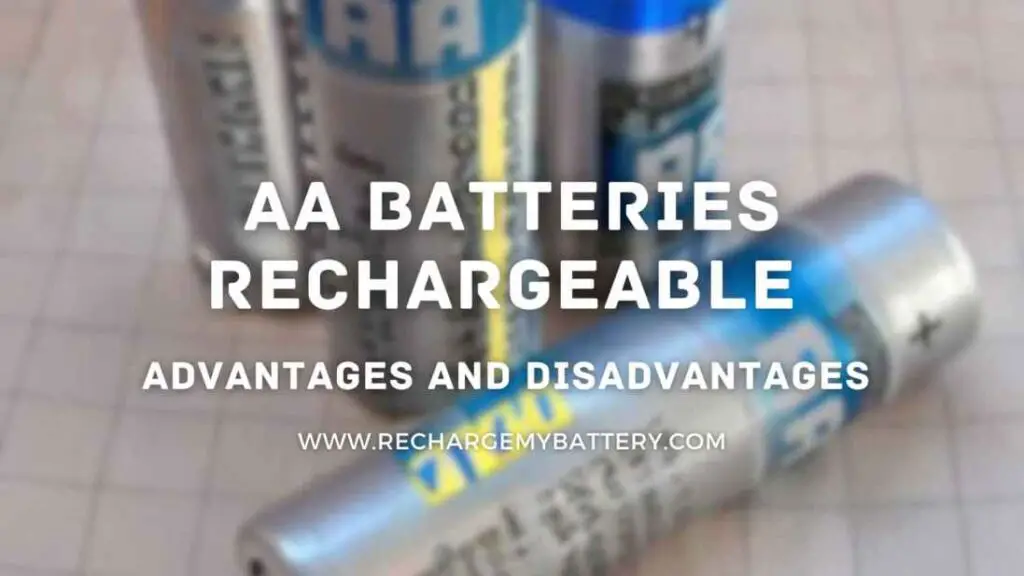In this article, we will delve into the factors that influence the lifespan of rechargeable AA batteries and offer practical tips to extend their longevity. Whether you rely on rechargeable batteries for your electronics, toys, or other devices, understanding their lifespan can help you optimize their usage and make informed decisions.
Understanding Rechargeable AA Batteries
Rechargeable AA batteries, also known as secondary batteries, are designed to be reusable and offer an eco-friendly alternative to disposable batteries.
Unlike single-use batteries that are discarded after depletion, rechargeable batteries can be recharged and used multiple times. They are available in various chemistries such as:
- Nickel-metal hydride (NiMH)
- Lithium-ion (Li-ion)
It provides different performance characteristics and capacities.
Rechargeable AA batteries are commonly used in a wide range of devices, including electronics, toys, cameras, and portable audio devices. By using rechargeable AA batteries, you can reduce waste and save money in the long run while enjoying the convenience of easily replaceable power sources.
Factors Affecting the Lifespan of Rechargeable AA Batteries
Several factors influence the lifespan of rechargeable AA batteries. By understanding these factors, you can take steps to maximize their longevity and ensure optimal performance.
1. Battery Capacity and Chemistry
The capacity and chemistry of a rechargeable AA battery can affect its lifespan. Different chemistries, such as NiMH (Nickel-Metal Hydride) and Lithium-ion, have varying capacities and characteristics.
- NiMH batteries are commonly used in rechargeable AA batteries and offer a higher capacity but may experience self-discharge over time.
- Lithium-ion batteries, on the other hand, have a lower self-discharge rate and can provide longer-lasting power.
2. Charging and Discharging Cycles
The number of charging and discharging cycles a battery undergoes impacts its lifespan. Each cycle involves fully charging the battery and then discharging it until it needs recharging again.
Rechargeable AA batteries have a limited number of cycles they can endure before their performance starts to degrade. To maximize their lifespan, it’s important to follow proper charging practices and avoid deep discharges.
3. Storage Conditions
How you store rechargeable AA batteries when they are not in use can significantly affect their longevity. Extreme temperatures, such as excessive heat or cold, can degrade the battery’s performance and shorten its lifespan. It is best to store them in a cool, dry place away from direct sunlight and extreme temperature fluctuations.
By considering these factors and taking appropriate measures, such as using the correct charging techniques and storing batteries properly, you can extend the lifespan of rechargeable AA batteries and ensure reliable and long-lasting performance.
Comparing Rechargeable AA Batteries to Disposable Batteries
Rechargeable AA batteries offer several advantages over disposable batteries. By considering these benefits, you can make an informed decision about which type of battery best suits your needs.
1. Cost Savings
Although rechargeable batteries may have a higher initial cost compared to disposable batteries, they provide significant long-term cost savings.
Rechargeable batteries can be reused multiple times, eliminating the need for frequent battery purchases. Over time, this can result in substantial savings, especially for devices that require frequent battery replacements.
2. Environmental Impact
Rechargeable AA batteries are a more environmentally friendly choice. Disposable batteries contribute to waste accumulation, as they are thrown away after a single use.
Rechargeable batteries, on the other hand, reduce waste by being reusable. By using rechargeable batteries, you can help minimize the number of batteries that end up in landfills and reduce your environmental footprint.
3. Convenience
Rechargeable batteries offer convenience and flexibility. Instead of constantly buying and replacing disposable batteries, you can simply recharge your rechargeable batteries when they are depleted. This can be especially advantageous for devices with high power consumption or those used frequently.
4. Performance
Rechargeable AA batteries generally provide comparable performance to disposable batteries. They offer reliable power output and can be recharged to their full capacity, ensuring consistent performance over multiple cycles.
However, it’s important to choose rechargeable batteries with appropriate capacity and chemistry to match the power requirements of your devices.
While rechargeable AA batteries have clear advantages, it’s worth noting that disposable batteries still have their place in certain situations. Disposable batteries are typically more readily available in emergency situations or when traveling to remote areas where recharging options may be limited.
Ultimately, the choice between rechargeable and disposable batteries depends on your specific needs, budget, and environmental considerations. Assessing factors such as long-term cost, environmental impact, convenience, and device compatibility will help you determine the most suitable option for your requirements.
Pros and Cons of Rechargeable AA Batteries
Pros:
- Cost-effective in the long run
- Environmentally friendly
- Available in different chemistries and capacities
- Can be used in a wide range of devices
Cons:
- Initial higher cost compared to disposable batteries
- A limited number of charging cycles before performance degradation
- Some rechargeable batteries may self-discharge over time
Extending the Lifespan of Rechargeable AA Batteries
1. Proper Charging Practices
To maximize the lifespan of rechargeable AA batteries, it is important to follow proper charging practices. By adhering to these guidelines, you can ensure optimal performance and longevity of your batteries:
1.1. Use a Compatible Charger
Always use a charger specifically designed for rechargeable batteries and ensure it is compatible with AA batteries. Using the correct charger helps prevent overcharging and ensures safe and efficient charging.
1.2. Avoid Overcharging
Overcharging can lead to overheating and reduced battery lifespan. Once the batteries are fully charged, disconnect them from the charger promptly. Modern chargers often have built-in safety features to prevent overcharging, but it’s still advisable to monitor the charging process.
1.3. Charging Time
Follow the recommended charging time specified by the battery manufacturer. Charging times may vary depending on the battery capacity and charger specifications. Avoid leaving batteries on the charger for longer than necessary, as this can potentially degrade their performance.
1.4. Unplug Unused Chargers
When not in use, unplug the charger from the power source. Some chargers consume a small amount of standby power even when not charging batteries. Unplugging them not only saves energy but also eliminates any risk of electrical hazards.
1.5. Avoid Fast Charging
While fast charging can be convenient, it may generate more heat and put additional stress on the batteries. If possible, opt for a slower or standard charging mode, as it tends to be gentler on the batteries and helps prolong their lifespan.
Following these proper charging practices will help maintain the performance and longevity of your rechargeable AA batteries. By ensuring safe and efficient charging, you can get the most out of your batteries and enjoy their long-term usability.
2. Battery Maintenance Tips
To ensure the optimal performance and longevity of your rechargeable AA batteries, it is important to follow these maintenance tips:
2.1. Avoid Deep Discharges
Try to recharge the batteries before they are completely drained. Deep discharges can negatively impact the battery’s lifespan and overall performance. Recharge them when they reach around 20-30% capacity remaining.
2.2. Keep Battery Contacts Clean
Periodically inspect the battery contacts for any dirt, corrosion, or residue. If necessary, gently wipe the contacts with a clean, dry cloth to ensure good electrical conductivity. Dirty contacts can hinder the battery’s performance and cause charging or power delivery issues.
2.3. Use the Batteries Regularly
If you have rechargeable batteries that are not in frequent use, it is recommended to charge and discharge them periodically. This helps prevent the batteries from entering a prolonged idle state, which can lead to capacity loss. Charging and discharging them at least once every few months helps maintain their performance.
2.4. Store Batteries Properly
When storing rechargeable AA batteries, ensure they are in a cool, dry place away from direct sunlight and extreme temperatures. High temperatures can accelerate self-discharge and shorten the battery’s lifespan. Avoid storing batteries in locations prone to excessive heat or cold, such as inside a car or near heating/cooling appliances.
2.5. Replace Damaged Batteries
If you notice any signs of damage, such as leakage, deformation, or a significant decrease in performance, it is advisable to replace the batteries. Damaged batteries can pose safety risks and may not provide optimal performance.
Recycling and Disposal
Here are some guidelines for recycling and disposal:
- Check Local Recycling Programs – Research local recycling programs or facilities that accept rechargeable batteries. Many communities have designated drop-off locations or recycling centers specifically for batteries. Contact your local waste management authority, recycling center, or electronic retailers to find out where you can recycle your rechargeable AA batteries.
- Separate Batteries – Before recycling, it is recommended to keep rechargeable AA batteries separate from other types of batteries. This helps ensure they are handled and processed correctly.
- Protect Terminals – To prevent any accidental short-circuits, you can cover the terminals of the batteries with tape or place them in individual plastic bags before recycling.
- Follow Instructions – Different recycling programs may have specific instructions or guidelines for battery recycling. Follow their instructions carefully to ensure proper disposal.
- Take Advantage of Retailer Programs – Some electronic retailers offer recycling programs for rechargeable batteries. They may have collection bins in-store where you can drop off your used batteries for recycling.
Conclusion
In conclusion, understanding the factors that affect the lifespan of rechargeable AA batteries and implementing proper charging practices, battery maintenance, and recycling and disposal methods can help you get the most out of your batteries.
By following these tips, you can extend the lifespan of your rechargeable AA batteries, save money in the long run, and contribute to environmental sustainability by reducing waste. Rechargeable AA batteries offer a reliable and eco-friendly power solution for various devices, making them a wise choice for both your pocket and the planet.
Thank you for reading it.


